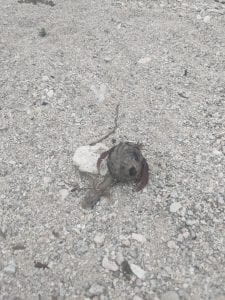Wow. Today really felt like a marathon: an awesome, sweaty, exhausting, educational marathon. Most of the day we spent setting up camera traps. This effort involved countless machete hacks, tons of bug spray, and a lot of good laughs.
On the trails, Scott and Kory turned over a couple of logs which revealed the homes of a couple cockroaches! From my taxon ID card I think they were either Smokybrown cockroaches or Oriental cockroaches, but they ran away quickly so it was a bit difficult to tell. I can’t believe I’m actually starting to get excited about seeing those little creatures. We also spotted a large cat paw-print on the trail, and decided to get creative by making an even larger footprint of own.
It was really awesome to see all of the micro-habitats on the rainforest floor. It seems like each and every leaf conceals a unique habitat and lifecycle of its own. I also loved noticing all of the twisting and turning vines and plants I had only seen in expensive houses before.
Tonight’s lectures were quite interesting and spotlighted orthoptera, reptiles, and the history of biogegraphic development in Central America. I learned about the jumping mechanisms of grasshoppers (something we get to see in action each day in the field/LCRS), stridulation, and the significance of orthopera in reflecting broader microclimatic conditions. It was also fascinating to hear about all of the unique species of reptiles just in the Belizian rainforest.
Tomorrow will be another big nature day and I am excited to get back out there!
-Emily

















